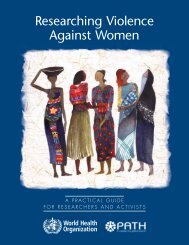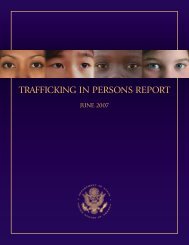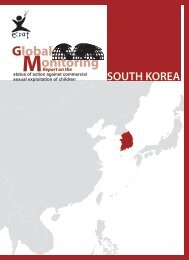Download PDF - Violence Against Children - East Asia and the ...
Download PDF - Violence Against Children - East Asia and the ...
Download PDF - Violence Against Children - East Asia and the ...
Create successful ePaper yourself
Turn your PDF publications into a flip-book with our unique Google optimized e-Paper software.
introduction<br />
Current challenges of project<br />
design <strong>and</strong> operation<br />
Inclusion of vulnerable groups<br />
“A fundamental political aspect of safety net<br />
design <strong>and</strong> targeting is <strong>the</strong> choice of whe<strong>the</strong>r to<br />
help <strong>the</strong> poor <strong>and</strong> ultra-poor or <strong>the</strong> more vocal,<br />
politically more powerful groups.” 19<br />
inclusion through practice. In Cambodia,<br />
World Vision has conducted research into<br />
community <strong>and</strong> institutional views on <strong>the</strong><br />
problem of child sex tourism in cooperation<br />
with key government ministries <strong>and</strong> national<br />
children’s organisations, 20 <strong>and</strong> successfully<br />
advocated for intentional action to combat<br />
child sex tourism as part of development of<br />
<strong>the</strong> tourist industry. Cambodia’s<br />
Government, <strong>the</strong> private sector <strong>and</strong><br />
international financial institutions such as <strong>the</strong><br />
<strong>Asia</strong>n Development Bank now include action<br />
to streng<strong>the</strong>n child protection in this area.<br />
Issues of improved access to education <strong>and</strong><br />
health care to benefit children are a<br />
consistent feature of community<br />
development. Responses to o<strong>the</strong>r issues that<br />
place children at risk, such as disability,<br />
“Poverty is <strong>the</strong> single greatest force<br />
domestic violence <strong>and</strong> exploitation, are often<br />
which creates <strong>the</strong> flow of children into<br />
regarded as specialist areas <strong>and</strong> not included<br />
<strong>the</strong> workplace…” 21<br />
as part of program design. Inclusion is<br />
possible, however, <strong>and</strong> is a feature of a<br />
Poverty<br />
number of projects; experience in <strong>the</strong>se<br />
environments can be shared <strong>and</strong> useful<br />
Child labour is a common phenomenon in<br />
many poor areas. Approaches to raising<br />
approaches extended upon.<br />
awareness <strong>and</strong> response on child labour at <strong>the</strong><br />
The presence of a minority group as part of community level are an established feature of<br />
a beneficiary population needs to be<br />
some development work, but <strong>the</strong>re is<br />
acknowledged intentionally in project design. opportunity for extension from lessons<br />
Projects working where such groups<br />
learned. If not addressed, this gap in project<br />
experience discrimination, violence or lack of design allows for continued acceptance of<br />
opportunity need to account for <strong>the</strong> political children being part of family economies in<br />
dimensions of <strong>the</strong> task as much as <strong>the</strong> service ways that may be damaging to <strong>the</strong>m.<br />
delivery concerns. Approaches where<br />
Underst<strong>and</strong>ing attitudes <strong>and</strong> promoting<br />
advocacy is clearly part of project design are alternative views in <strong>the</strong> interests of children<br />
able to extend from <strong>the</strong> “micro” community are sometimes required. Consideration is<br />
context to <strong>the</strong> “macro” national <strong>and</strong> political needed for families on <strong>the</strong> edge who are not<br />
context. Unfortunately, however, this is often eligible for credit. Poverty-enforced mobility<br />
not <strong>the</strong> case: capacity to advocate is often <strong>and</strong> insecurity increase <strong>the</strong> risks that <strong>the</strong>ir<br />
not part of design but an added task at <strong>the</strong> children face. They may move on from a<br />
discretion of project staff; <strong>the</strong> result is that rural community <strong>and</strong> drift to <strong>the</strong> city, where<br />
opportunity to promote change on issues of <strong>the</strong> children will be at greater risk from<br />
social justice, beyond direct service provision, predators. Highly mobile families need a<br />
is limited.<br />
response more typical of relief projects but<br />
this is often not available; <strong>the</strong> predominant<br />
Save <strong>the</strong> <strong>Children</strong>’s strong child-focused mode of assistance is through sustainable<br />
advocacy approach in Sri Lanka <strong>and</strong> Indonesia development programs, for which <strong>the</strong>y are<br />
offers good examples of linking local concerns not eligible. Cambodia offers models of goodpractice<br />
targeted assistance, from <strong>the</strong> League<br />
to a national agenda through advocacy. World<br />
Vision’s approach in Vietnam has facilitated for <strong>the</strong> Promotion <strong>and</strong> Defence of Human<br />
significant change through advocating for Rights (LICADHO), Mith Samlanh/Friends,<br />
disabled children while demonstrating<br />
<strong>and</strong> World Vision.<br />
19 Klugman, 2001<br />
20 <strong>Children</strong>’s Work, Adults’ Play: Child sex tourism – <strong>the</strong> problem in Cambodia, World Vision International, 2001<br />
21 International Labour Organization Conference, 86th Session, Geneva, 1996<br />
18

















